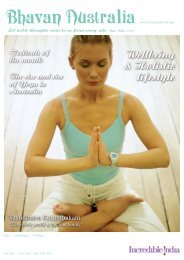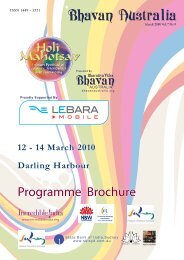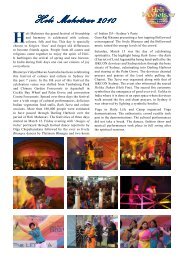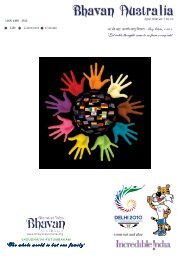World Peace - Bharatiya Vidya Bhavan Australia
World Peace - Bharatiya Vidya Bhavan Australia
World Peace - Bharatiya Vidya Bhavan Australia
Create successful ePaper yourself
Turn your PDF publications into a flip-book with our unique Google optimized e-Paper software.
Tam evam vidvan amritamiha bhavati<br />
Nanyah panta ayanaya vidyate<br />
One becomes immortal only by knowing Him, there is<br />
no other way for attaining Him.<br />
It is the Agama cult, which developed into the Bhakti<br />
cult later on, that was taken up by Chaitanya and Sri<br />
Ramkrishna. It is therefore possible to see how the<br />
agama cult developed. The Vedic rituals were aimed<br />
at attaining some material gain, which is not recommended<br />
by Manu, though yagnas and other rituals<br />
performed for the public good were recommended by<br />
him. While Vedanta was within the reach of a few,<br />
agama rituals were there for everyone. Since the objective<br />
was knowledge of the infinite, the bhakti yoga<br />
offered a simple method to all people aspiring for God<br />
knowledge. This is probably why the vaidika rites of<br />
five oblations declined from common use and the<br />
agama or Bhakti rituals gained in importance. Devotion<br />
to a personal God and meditating upon him prepared<br />
the aspirant for uninterrupted meditation on<br />
Him, ‘Ananya Chinta.’<br />
The agama texts consist of the means of worship of<br />
Shiva and Krishna (Ist and 2nd book), yoga in the<br />
third book, and jnana in the fourth. The Jnana of the<br />
Agamas is different from the Upanishads. The Upanishads<br />
speak of one reality behind the universe while<br />
the Agamas have the ‘tatva trayam’ or the three fold<br />
reality i.e. Iswara, the individual and matter. Hence it<br />
can be said that the Agamas are the Scriptures for<br />
the Bhakti Marga and the Upanishads the scriptures<br />
for the Jnana Marga. Jnana Marga is meant for the<br />
few as it is difficult while the Bhakti Marga is available<br />
to all. Even a low caste man can attain moksha<br />
by Bhakti Marga whereas the Jnana Marga is open<br />
mainly to the Brahmins. The Tamil Alwars and<br />
Sivanadiars attained enlightenment even though<br />
many of them were of low caste. It looks however<br />
that the Bhagwad Gita was the precursor to the<br />
Agama cults as it showed the different ways and concluded<br />
that Bhakti yoga was the easiest and is available<br />
to everyone. The agamas became really very<br />
46 | <strong>Bhavan</strong> <strong>Australia</strong> | August 2012<br />
universal and did not recognize the caste system or<br />
Varna dharma. The Bhagawad Gita contains both<br />
Agama and Vedic teaching, it is essentially an appeal<br />
for the Agama system. The Mahabharata war left a<br />
lasting impact on the peoples of India and it is known<br />
that the Dasyus of the South, including the Pandya,<br />
and other kings participated in the war on the side of<br />
Pandavas.<br />
The Upanishads were evolved out of the Karma<br />
Kanda of the Vedas and this fact is reflected in references<br />
in the Chandogya and Brahadaranyaka Upanishads.<br />
The majority of the people, however, cannot<br />
fathom the depth of the Upanishadic teachings but<br />
being deeply religious, sought some way to attain<br />
moksha. The Dasyus of the South had a number of<br />
Agamic methods of worship like the worship of Murugan,<br />
Ganesa and so on. With the free mixing of the<br />
Aryans from the north, essentially brahmins, and the<br />
Tamils from the South, newer methods were found<br />
which led to the agamic Bhakti cult evolving subsequently.<br />
It was thus that the Vedic fire rites yielded<br />
place to fire-less rites and worship. 28 Saiva Agamas,<br />
108 Vaisnava agamas and 77 Sakti Agamas were compiled<br />
in later years and Panini refers to Siva and Krishna<br />
worships during his time itself.<br />
A slow process of integration of the Vedanta with the<br />
Agama school took place over the centuries. They existed<br />
separately in the puranas, and even<br />
sankaracharya (VII century AD) kept these two systems<br />
separate. His Prapanca Hradaya is a pure Agama<br />
work. However the essence of both systems as also<br />
their objectives remained the same viz: Self-realization<br />
or enlightenment. The Agama rites, evolved from<br />
pre Aryan Indian cults, subjugated the minds of South<br />
India after the 5th century AD, and blended with<br />
Vedanta, it trickled back to North India and eventually<br />
became what is known as Hinduism during the last<br />
1000 years.<br />
We can conclude, therefore, that the Vedic Tradition<br />
encompasses the entire range of literature starting<br />
with the Vedas, Upanishads, Puranas, Itihasas, Agamas<br />
and others. They contain methods or paths for every<br />
type of man to attain enlightenment. True knowledge<br />
leads to enlightenment or self-realization or self-knowledge.<br />
While fire worship and fire rites are the oldest<br />
forms of worship known to humanity all over the<br />
world, this gradually yielded place to worship of personal<br />
Gods without fire rites as it was easier for everyone<br />
to follow this method of worship. This however<br />
does not reduce the importance of the Upanishads as<br />
they constitute one complete analysis of thought, and<br />
contains practically every aspect of Logic, Psychology<br />
and Philosophy. It is as relevant today as it was in<br />
those days. But as we have said often, the result or objective<br />
is important and the form is not.









